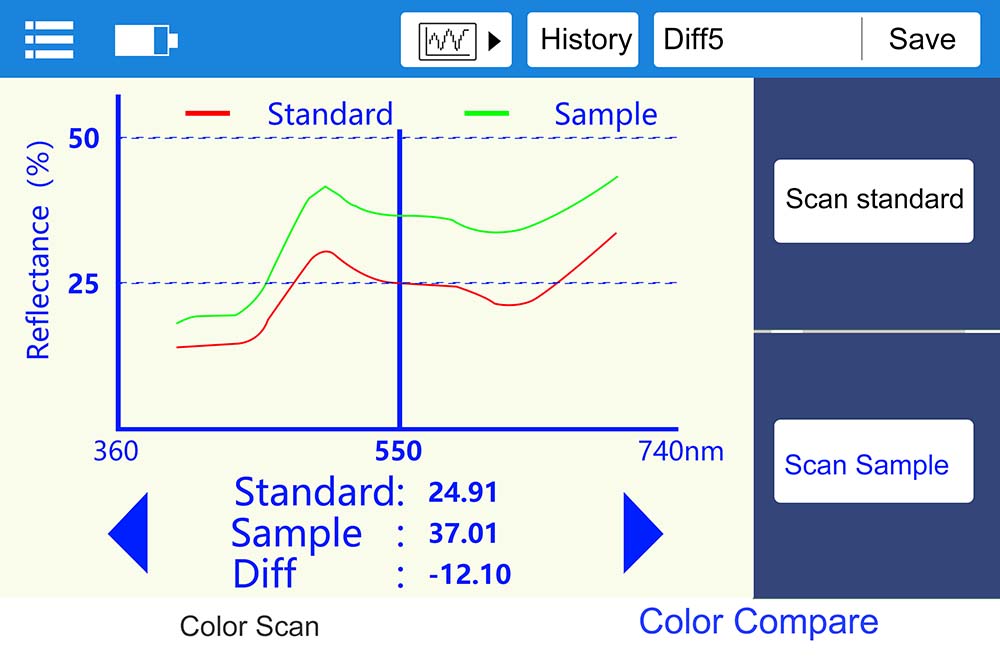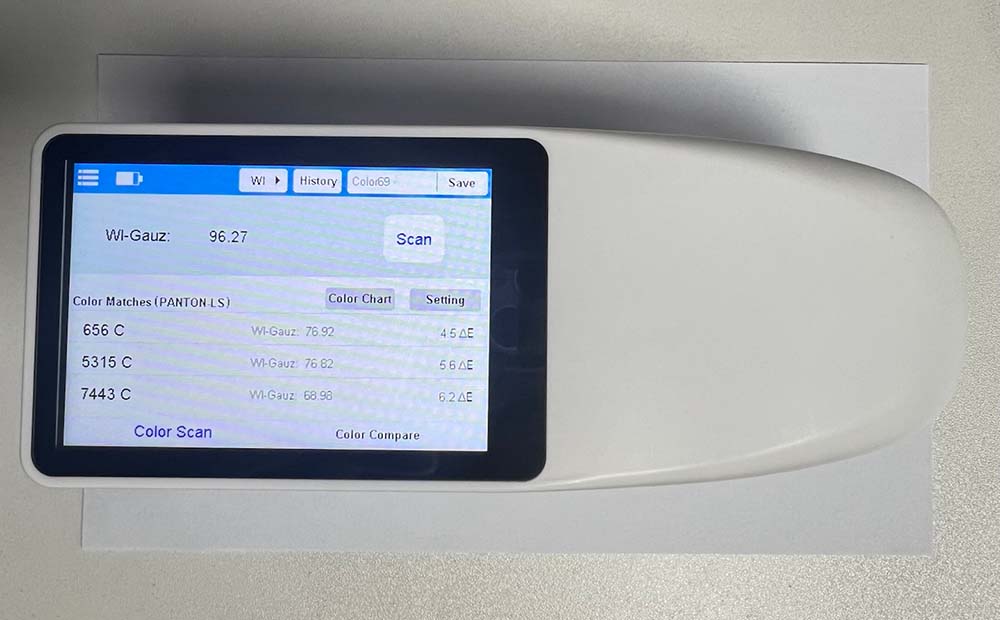Spectral reflectance, metamerism and whiteness
What is spectral reflectance?
When light strikes the surface of a sample, it is reflected. At this stage, the reflectance of the sample is defined as the ratio of the luminous flux of reflected light from the sample to the luminous flux of reflected light from a totally diffuse sample (ideal white sample). As a result, white has the highest reflectivity, close to 100%, while black has the lowest. A sample's reflectance is typically independent of the kind of light source and observer, and it can be a comprehensive description of the sample's color qualities.
Because visible light is made up of each color of light in the 380-780 nm range, the corresponding reflectance for a sample in each of these bands can be determined, and we link the reflectance of each band to form a curve - the reflectance spectrum curve.
What is the purpose of a reflectance curve?
A sample's reflectance spectral curve offers a wealth of color information, including the following:
The reflectance spectrum enables us to establish the sample's color. The color light that is the predominate color of the sample correlates to the highest point or area of the reflectance spectrum.
The reflection spectrum helps us to assess the sample's saturation. The greater the gap between the highest and lowest points of the reflection spectrum, the greater the sample's color saturation; the converse is true.
The reflectance spectrum allows us to calculate the color's brightness (color shade). The greater the total reflectance spectrum, the lighter the hue; conversely, the darker the color.
By the degree of curve fitting, we can judge whether there is the phenomenon of metamerism. If two color samples have different spectral reflectance curves ρ1 (λ) ≠ ρ2 (λ), and have the same tri-stimulus value, the two colors are called homochromatic heterospectral colors. That is to say, a color sensation does not correspond to only one spectral combination, while two complex colors of light with completely different components may cause the exact same color sensation.

What is metamerism?
Metamerism is explained from the wavelength point of view, which means that two objects have the same color, but the "spectrum" - the spectral reflectance curve is not the same. From an optical point of view, metamerism means that two objects have the same color under the same illumination source, but when the light source changes or the observation angle changes, the color of the object will change. That is to say, the homochromatic objects maintain their metamerism is conditional.

What causes metamerism?
Light source
Light is a kind of electromagnetic wave, and the part that can cause the human eye's visual sensation is called visible light. Different light sources are composed of different monochromatic or complex colors of light, and their color temperature and spectral energy distribution are different. It is normal for the color of the same object to be inconsistent under different light sources.
Product material
When too many materials are used in the production process of a product, the phenomenon of homochromatic spectrum often occurs. Automotive manufacturers are constantly battling this phenomenon. Therefore, they have to strictly monitor their products for homochromia when assembling parts from different suppliers. Photo-whitening agents also tend to trigger homochromatic aberrations in paper, fabrics and liquids. Observer color is the result of visible light in the observer's brain through its effect on the human eye. There are differences in the visual response given by the cone cells of different human eyes to the color of the same object.
Observer
Color is the result that visible light produces in the observer's brain through its effect on the human eye. The visual response to the color of the same object varies between the cone cells of the human eye.
How to avoid metamerism?
The Linshang LS176B spectrophotometer uses a full-spectrum LED light source with uniform spectral distribution in the visible range to provide stable light source testing conditions. The instrument's built-in data processing software contains spectral power distribution data from a variety of standard illuminants and spectral tri-stimulus value data from standard chromaticity observers, and a series of color parameters for the desired sample can be derived through the software's conversion function. Importantly, the instrument uses a unique curve fitting algorithm that provides a direct spectral reflectance curve for comparing the fit and trend direction of the products.
What is whiteness?
Whiteness indicates the degree of whiteness of a white or near-white sample, and the larger the value, the whiter it is. It is expressed in various ways, mainly blue whiteness and CIE whiteness, in addition to Gantz whiteness, Hunter whiteness, Berger whiteness, etc. Some common items in our life actually need to measure the whiteness value, such as flour, salt, textiles, paint, ceramics, paper, etc.
Why measure whiteness?
Take, for example, paper printing items; the whiteness of the paper will impact the color performance of the printed products. Paper with a high whiteness index can reflect a lot of color light. When ink is printed on the paper's surface, paper with a high whiteness may reflect the color light synthesized via the ink layer by eliminating color well, allowing the print to restore the ink color to the greatest degree possible.
And when the whiteness of the paper fades, its capacity to reflect color light drops, producing color deviation and color difference difficulties in the printing process. As a result, assessing the whiteness value of a printing paper is an excellent approach to prevent color difference or excessive color difference.

How is the whiteness value calculated?
Linshang manufactures spectrophotometers with three major whiteness assessment indicators: Whiteness-98, Gauz Whiteness, and Hunter Whiteness. There are several methods for measuring whiteness, however utilizing the LS176B spectrophotometer to measure whiteness value will save you a lot of time and provide you with the whiteness value of the test object with an one click measurement.
The measuring stages are as follows:
Start the instrument. Select the whiteness index to test in the color parameter setting by clicking on the menu bar in the top left corner.
Return to the color measurement interface and place the instrument on the test material's surface.
To acquire the whiteness value, click the measurement button.
After measuring the whiteness, click Store to save the data. The instrument can save 1000 sets of color data after connecting to the app, and it can retain a huge quantity of data, making it easy to recall the color data at any moment when measuring in the future.
- UV Printing Machine Pros and UV LED Energy Meter
- UV Energy Meter and Paint Thicknes Gauge in Paint Industry
- Spectacle Lenses Anti-blue Effect Testing
- IR Ink Working Principle and Transmittance Detection | Lens Transmission Meter
- How to Measure the Insulating Glass Thickness?
- What’s the Difference Between Point Light and Parallel Light Transmittance Meter